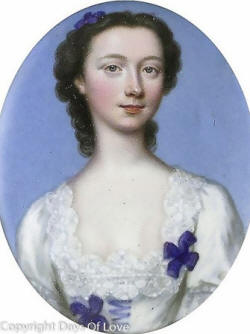

Partner Elizabeth
Carter
Queer Places:
Grosvenor St, Mayfair, London W1K 4PX
 Catherine
Talbot (May, 1721 – January 9, 1770) was an English Bluestocking, essayist, and letter writer. The letters exchanged by writers Elizabeth
Carter and Catherine Talbot during their lifelong romantic friendship
contained numerous expressions of romantic and physical love. Elizabeth Carter
wrote of her wild emotion for Talbot, claiming she is absolutely my passion; I
think of her all day, dream of her all night, and one way or other introduce
her into every subject I talk of. Talbot returned her feelings, sending her a
lock of her hair and playfully worrying on one occasion that Carter had fallen
in love with another woman, and the first is forgot.
Catherine
Talbot (May, 1721 – January 9, 1770) was an English Bluestocking, essayist, and letter writer. The letters exchanged by writers Elizabeth
Carter and Catherine Talbot during their lifelong romantic friendship
contained numerous expressions of romantic and physical love. Elizabeth Carter
wrote of her wild emotion for Talbot, claiming she is absolutely my passion; I
think of her all day, dream of her all night, and one way or other introduce
her into every subject I talk of. Talbot returned her feelings, sending her a
lock of her hair and playfully worrying on one occasion that Carter had fallen
in love with another woman, and the first is forgot.
Catherine Talbot was the posthumous and only child of Edward Talbot, second son of William Talbot, bishop of Durham, and his wife Mary (died 1784), daughter of George Martyn, prebendary of Lincoln. Her uncle Charles Talbot, another son of the bishop, was Lord Chancellor. Her father, Edward, who was elected fellow of Oriel College, Oxford, and appointed archdeacon of Berkshire in 1717, died on 9 December 1720. At the time of his death Catherine Benson (sister of Martin Benson, bishop of Gloucester) was residing at his house, and on her marriage to Thomas Secker, a protégé of Talbot, in 1725, Mrs. Talbot and Catherine, who were not well-off, went to live with the newly married couple and remained members of the household until Secker's death in 1768.
Catherine's education was superintended by Secker. She became learned in the Scriptures and an accomplished linguist. She also painted in watercolours and read widely. As a child her talent was recognised, for example by Thomas Rundle. February 1741 saw the beginning of her lifelong friendship with Elizabeth Carter; the introduction was by Wright, Miss Talbot's tutor in astronomy. The two ladies carried on a lively and copious correspondence.
As Secker was successively rector of St. James's, Westminster, bishop of Oxford, dean of St. Paul's, and finally in 1758 archbishop of Canterbury, Catherine Talbot frequented the society of her time. She knew among others Bishop Butler, Lord Lyttelton, William Pulteney, earl of Bath, Mrs. Montagu, the Duchess of Somerset, with whom she often stayed at Percy Lodge, and Samuel Richardson. Richardson discussed Sir Charles Grandison with her and Elizabeth Carter, adopted their suggestions, and sent them parts of the novel to read before publication. Catherine Talbot visited Richardson at North End, Hammersmith. She also encouraged Carter to translate Epictetus, and corresponded with her on the subject while the work was in progress.
Deeply devout, Talbot wrote treatises on scripture and other religious topics. Although she shared these with friends who admired her writing, she refused to allow the publication of all except one, which appeared in Samuel Johnson's Rambler in 1750. She was well known in London literary circles, and belonged to the group of well-educated women writers and scholars called the Bluestocking Circle. Talbot was also a prolific correspondent, and many of her letters to her Bluestocking friends have been preserved, including almost 30 years of letters to her closest friend, the poet Elizabeth Carter .
The romantic feelings Elizabeth had for her closest friend, Catherine Talbot, were expressed through her writing, in this case in letters to Catherine. They found each other in 1741, but had little personal time together – Catherine was an invalid, cared for by her mother. A translation of the works of the Greek philosopher Epictetus was so well received that Elizabeth was able to live independently on the proceeds, and devote her time to nurturing her thirty-year romance with Catherine. After Catherine died in 1770, Elizabeth made the acquaintance of the Bluestockings, female intellectuals such as Elizabeth Montagu, and she also knew other great thinkers of the day such as Fanny Burney. Catherine’s mother left a bequest to Elizabeth that enabled her to continue to live independently till her death in 1806, a gesture that suggests she valued the feelings Elizabeth had for her daughter and did not think ill of them.
During the whole period of her residence with him Catherine Talbot was Secker's almoner. In 1760, accompanied by Elizabeth Carter, she went to Bristol for her health. Secker died in 1768, leaving to Mrs. Talbot and her daughter £13,000 in the public funds. The ladies moved from Lambeth Palace to Lower Grosvenor Street.
After suffering many years of ill health, Catherine Talbot died at age 49 of cancer. Carter arranged for the posthumous publication of Talbot's collected religious essays, entitled Reflections on the Seven Days of the Week. A second collection, Essays on Various Subjects, appeared in 1772. Her work also appeared in the 1792 anthology The Athenian Letters. Talbot's letters to Carter, for which she was best known in the 19th century, were collected and published by Carter's nephew in 1809.
My published books: